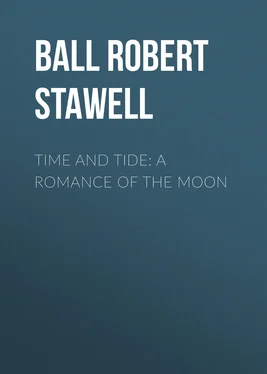Robert Ball - Time and Tide - A Romance of the Moon
Здесь есть возможность читать онлайн «Robert Ball - Time and Tide - A Romance of the Moon» — ознакомительный отрывок электронной книги совершенно бесплатно, а после прочтения отрывка купить полную версию. В некоторых случаях можно слушать аудио, скачать через торрент в формате fb2 и присутствует краткое содержание. Жанр: foreign_antique, Физика, foreign_edu, на английском языке. Описание произведения, (предисловие) а так же отзывы посетителей доступны на портале библиотеки ЛибКат.
- Название:Time and Tide: A Romance of the Moon
- Автор:
- Жанр:
- Год:неизвестен
- ISBN:нет данных
- Рейтинг книги:5 / 5. Голосов: 1
-
Избранное:Добавить в избранное
- Отзывы:
-
Ваша оценка:
- 100
- 1
- 2
- 3
- 4
- 5
Time and Tide: A Romance of the Moon: краткое содержание, описание и аннотация
Предлагаем к чтению аннотацию, описание, краткое содержание или предисловие (зависит от того, что написал сам автор книги «Time and Tide: A Romance of the Moon»). Если вы не нашли необходимую информацию о книге — напишите в комментариях, мы постараемся отыскать её.
Time and Tide: A Romance of the Moon — читать онлайн ознакомительный отрывок
Ниже представлен текст книги, разбитый по страницам. Система сохранения места последней прочитанной страницы, позволяет с удобством читать онлайн бесплатно книгу «Time and Tide: A Romance of the Moon», без необходимости каждый раз заново искать на чём Вы остановились. Поставьте закладку, и сможете в любой момент перейти на страницу, на которой закончили чтение.
Интервал:
Закладка:
There are many drawbacks to a tide-mill of this description. In the first place, its situation would naturally be far removed from other conveniences necessary for manufacturing purposes. Then too there is the great irregularity in the way in which the power is rendered available. At certain periods during the twenty-four hours the mill would stop running, and the hours when this happened would be constantly changing. The inconvenience from the manufacturer's point of view of a deficiency of power during neap tides might not be compensated by the fact that he had an excessive supply of power at spring-tides. Before tide-mills could be suitable for manufacturing purposes, some means must be found for storing away the energy when it is redundant, and applying it when its presence is required. We should want in fact for great sources of energy some contrivance which shall fulfil the same purpose as the accumulators do in an electrical installation.
Even then, however, the financial consideration remains, as to whether the cost of building the dam and maintaining the tide-mill in good order will not on the whole exceed the original price and the charges for the maintenance of a hundred horse power steam-engine. There cannot be a doubt that in this epoch of the earth's history, so long as the price of coal is only a few shillings a ton, the tide-mill, even though we seem to get its power without current expense, is vastly more expensive than a steam-engine. Indeed, Sir William Thomson remarks, that wherever a suitable tidal basin could be found, it would be nearly as easy to reclaim the land altogether from the sea. And if this were in any locality where manufactures were possible, the commercial value of forty acres of reclaimed land would greatly exceed all the expenses attending the steam-engine. But when the time comes, as come it apparently will, that the price of coal shall have risen to several pounds a ton, the economical aspect of steam as compared with other prime movers will be greatly altered; it will then no doubt be found advantageous to utilize great sources of energy, such as Niagara and the tides, which it is now more prudent to let run to waste.
For my argument, however, it matters little that the tides are not constrained to do much useful work. They are always doing work of some kind, whether that be merely heating the particles of water by friction, or vaguely transporting sand from one part of the ocean to the other. Useful work or useless work are alike for the purpose of my argument. We know that work can never be done unless by the consumption or transformation of energy. For each unit of work that is done—whether by any machine or contrivance, by the muscles of man or any other animal, by the winds, the waves, or the tides, or in any other way whatever—a certain equivalent quantity of energy must have been expended. When, therefore, we see any work being performed, we may always look for the source of energy to which the machine owes its efficiency. In fact, it is the old story illustrated, that perpetual motion is impossible. A mechanical device, however ingenious may be the construction, or however accurate the workmanship, can never possess what is called perpetual motion. It is needless to enter into details of any proposed contrivance of wheels, of pumps, of pulleys; it is sufficient to say that nothing in the shape of mechanism can work without friction, that friction produces heat, that heat is a form of energy, and that to replace the energy consumed in producing the heat there must be some source from which the machine is replenished if its motion is to be continued indefinitely.
Hence, as the tides may be regarded as a machine doing work, we have to ascertain the origin of that energy which they are continually expending. It is at this point that we first begin to feel the difficulties inherent in the theory of tidal evolution. I do not mean difficulties in the sense of doubts, for up to the present I have mentioned no doubtful point. When I come to such I shall give due warning. By difficulties I now mean points which it is not easy to understand without a little dynamical theory; but we must face these difficulties, and endeavour to elucidate them as well as we can.
Let us first see what the sources of energy can possibly be on which the tides are permitted to draw. Our course is simplified by the fact that the energy of which we have to speak is of a mechanical description, that is to say, not involving heat or other more obscure forms of energy. A simple type of energy is that possessed by a clock-weight after the clock has been wound. A store of power is thus laid up which is gradually doled out during the week in small quantities, second by second, to sustain the motion of the pendulum. The energy in this case is due to the fact that the weight is attracted by the earth, and is yielded according as the weight sinks downwards. In the separation between two mutually attracting bodies, a store of energy is thus implied. What we learn from an ordinary clock may be extended to the great bodies of the universe. The moon is a gigantic globe separated from our earth by a distance of 240,000 miles. The attraction between these two bodies always tends to bring them together. No doubt the moon is not falling towards the earth as the descending clock-weight is doing. We may, in fact, consider the moon, so far as our present object is concerned, to be revolving almost in a circle, of which the earth is the centre. If the moon, however, were to be stopped, it would at once commence to rush down towards the earth, whither it would arrive with an awful crash in the course of four or five days. It is fortunately true that the moon does not behave thus; but it has the ability of doing so, and thus the mere separation between the earth and the moon involves the existence of a stupendous quantity of energy, capable under certain conditions of undergoing transformation.
There is also another source of mechanical energy besides that we have just referred to. A rapidly moving body possesses, in virtue of its motion, a store of readily available energy, and it is easy to show that energy of this type is capable of transformation into other types. Think of a cannon-ball rushing through the air at a speed of a thousand feet per second; it is capable of wreaking disaster on anything which it meets, simply because its rapid motion is the vehicle by which the energy of the gunpowder is transferred from the gun to where the blow is to be struck. Had the cannon been directed vertically upwards, then the projectile, leaving the muzzle with the same initial velocity as before, would soar up and up, with gradually abating speed, until at last it reached a turning-point, the elevation of which would depend upon the initial velocity. Poised for a moment at the summit, the cannon-ball may then be likened to the clock-weight, for the entire energy which it possessed by its motion has been transformed into the statical energy of a raised weight. Thus we see these two forms of energy are mutually interchangeable. The raised weight if allowed to fall will acquire velocity, or the rapidly moving weight if directed upwards will acquire altitude.
Конец ознакомительного фрагмента.
Текст предоставлен ООО «ЛитРес».
Прочитайте эту книгу целиком, на ЛитРес.
Безопасно оплатить книгу можно банковской картой Visa, MasterCard, Maestro, со счета мобильного телефона, с платежного терминала, в салоне МТС или Связной, через PayPal, WebMoney, Яндекс.Деньги, QIWI Кошелек, бонусными картами или другим удобным Вам способом.
Интервал:
Закладка:
Похожие книги на «Time and Tide: A Romance of the Moon»
Представляем Вашему вниманию похожие книги на «Time and Tide: A Romance of the Moon» списком для выбора. Мы отобрали схожую по названию и смыслу литературу в надежде предоставить читателям больше вариантов отыскать новые, интересные, ещё непрочитанные произведения.
Обсуждение, отзывы о книге «Time and Tide: A Romance of the Moon» и просто собственные мнения читателей. Оставьте ваши комментарии, напишите, что Вы думаете о произведении, его смысле или главных героях. Укажите что конкретно понравилось, а что нет, и почему Вы так считаете.












